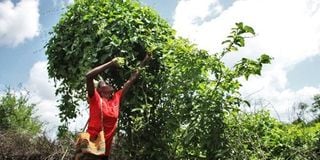Indigenous vegetables helping save the planet

What you need to know:
- Over and above the nutritional, medicinal and commercial values of indigenous vegetables, scientists place them at the centre of managing the adverse effects of climate change.
- Many of the indigenous vegetables such as kunde are better adapted to drought and common pests and diseases compared to the exotic crops.
The onset of the rainy season sets off a frenzied mukauw'u harvesting spree lasting for three months at Maikuu, a sleepy village in Makueni County. Irene Mwikali is among the sworn enthusiasts of the popular indigenous vegetable in the region bordering Chyullu Hills National Park. Recently, she has witnessed a sharp decline in the consumption of the vegetable, thanks to the fencing off of the park where it grows in the wild, intense pressure from stereotypes and competition from exotic vegetables.
In a bid to reverse the trend and prevent eminent outage of the popular vegetable, residents in the region have embarked on domesticating the deciduous liana known scientifically as Kedrostis Pseudogijef even as scientists list the plant among hardy indigenous vegetables which hold the key to managing the adverse impacts of climate change.
“Mukauw’u is our favourite vegetable. We no longer go far to access it,” Ms Mwikali told the Nation while filling her basket from a giant shrub planted by her grandmother three years ago. The vegetable is known for emitting a pungent smell during cooking. “However, we discard the water we use to boil mukauw’u to clear the strong smell. The vegetable is irresistibly tasty even when it is not fried. We eat it with ugali and mash with githeri,” Ms Mwikali added.
According to the World Agroforestry Centre, Kedrostis Pseudogijef is found in Kenya, Ethiopia, Uganda and Tanzania. In Kenya, it does well in some sections of Kitui, Makueni, Taita Taveta, and Marsabit counties. Although mukauw’u is not yet as mainstream as cowpeas (kunde), Amaranth (mchicha), African nightshade (managu), Spider plant (saga), bitter lettuce (mchunga) and pumpkin leaves, it is the most popular indigenous vegetable in Kibwezi and Mutomo region in Kitui County, where harvesters tend to perch on the shrubs along key roads as they go for the young leaves and tendrils after exhausting the low hanging ones.
It is now sold in local markets, marking a major milestone in its mainstreaming journey. Consequently, the vegetable has outgrown the misconception notion that it is a preserve of Ngulya, an indigenous Kamba community found predominantly in Kitui and Makueni counties, thanks to a strong wave of dietary consciousness sweeping across the country.
Mukauw’u is among indigenous vegetables the government has listed for promoting actively under the Natural Products Industry Initiative, which is domiciled at the National Museums of Kenya.
Buoyed by the changing attitude towards indigenous vegetables among elites, the national coordinator at the Natural Products Industry Initiative, Evans Taracha, predicts an explosion in the African indigenous vegetables industry.
Making a case of the role of indigenous knowledge in managing climate change and pandemics during the 7th Devolution Conference held in Makueni County recently, Dr Taracha said; “African indigenous vegetables are well endowed with valuable nutritional properties including high quantities of antioxidants, the antidote of free radicals, components which are harmful to the body. Once science revealed that and with the advent of healthy living, the demand for African indigenous vegetables has skyrocketed. Elites have now embraced African indigenous vegetables while the government has embarked on the commercialisation of African indigenous vegetables”.
Climate change
Over and above the nutritional, medicinal and commercial values of indigenous vegetables, scientists place them at the centre of managing the adverse effects of climate change.
“Many of the indigenous vegetables such as kunde are better adapted to drought and common pests and diseases compared to the exotic crops,” said Mary Mbenge, an environmentalist and the chief officer at the Department of Climate Change in Makueni County.
Indigenous vegetables such as pumpkins are key components of regenerative agriculture. According to George Mabuka, the manager in charge of climate smart agriculture at Cereal Growers Association, an NGO that promotes sustainable agriculture in Embu and Makueni counties, regenerative agriculture emphasises the use of a combination of simple soil and water conservation practices such as crop rotation, mulching, the use of terraces, tapping surface runoffs, and planting holes which are now improved to enhance their effectiveness.
The approach, which is taking farmers by storm, also includes the planting of indigenous crops such as pumpkins which primarily serve as cover crops to suppress weeds and cushion soils from direct sunlight. “The essence of regenerative agriculture is to restore soils that have been exhausted by overuse. Smallholder farmers who have adopted the soil and water conservation methods have posted bumper harvest even when the rains are minimal,” Mr Mabuka said.
To stay ahead of the indigenous vegetables curve and avoid running out of their popular vegetable, mukauw’u enthusiasts have embarked on domesticating the shrub by planting its cuttings in farms and hedges, complementing the natural ecosystems that are threatened by the clearing of forests to create farmlands.
According to Ms Mbenge, domesticating Kedrostis Pseudogijef and conserving the bushes where it climbs plays into the hands of environmental conservation, which sits at the heart of campaigns to mitigate global warming and climate change.




